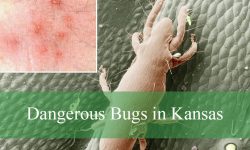Among the most fascinating animals in the natural world are caterpillars, due to their wide range of shapes, colors, and patterns. Of them, blue caterpillars are particularly interesting and mysterious creatures, with colors varying from light blue to rich indigo.
This comprehensive guide will cover 16 species of blue caterpillars, replete with pictures and detailed identification guidelines.
Different Types of Blue Caterpillars
Columbia Silk Moth Caterpillar
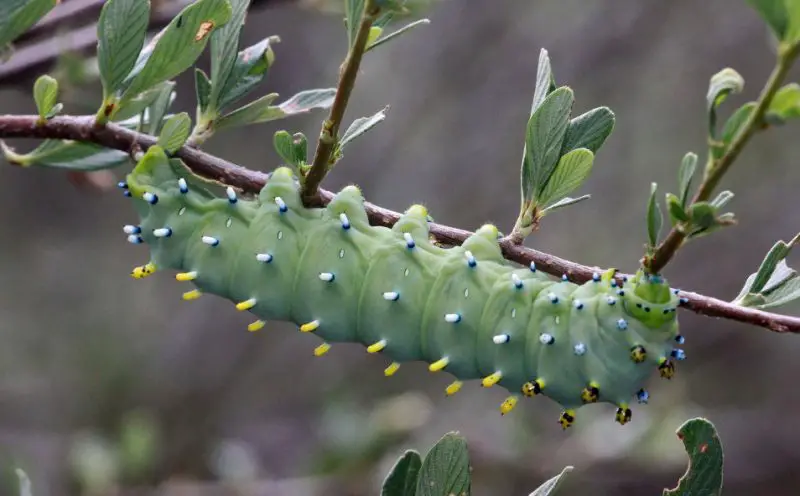
The Eastern Larch, commonly known as the American Larch, is the principal food source for the Columbia Silk Moth Caterpillar, formally known as Hyalophora columbia. Alder trees are another important host. These caterpillars, which are found in parts of the Eastern United States and Eastern Canada, undergo a noticeable color change as they mature.
When young, they are a bright green color, but as they get older, they become a more muted green-blue color. But as they approach pupation, their vibrant show comes to an end, and the adult moth becomes primarily gray and brown.
The uncommon white and brown bands and stripes on the Columbia Silk Moth’s body contrast with the gray underwings, which indicate how the moth changed from a vividly colored caterpillar to an adult with more subdued colors.
Jeweled Tailed Slug Moth Caterpillar
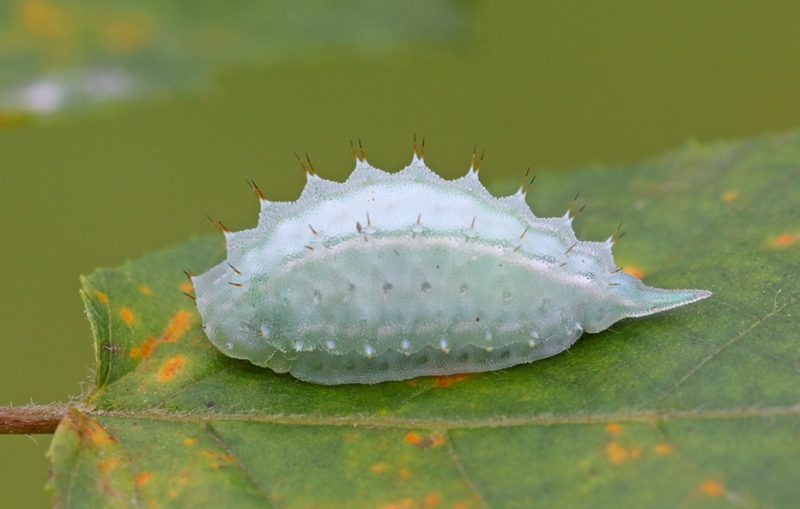
The scientific name for the Jeweled Tailed Slug Moth Caterpillar is Packardia geminata. It starts off as a pure white caterpillar and eventually turns a beautiful blue-green as it ages. With their long oval bodies resembling slugs, these caterpillars cleverly avoid predators by disappearing into their environment.
They mostly live on a range of hardwood trees, but their preferred hosts are hickory and oak. These caterpillars add to ecological diversity, but during infestations, their presence can become troublesome.
They have a history of penetrating the bark and entering the host trees, where they may do serious harm. This tunneling habit emphasizes how crucial it is to keep an eye on their numbers in order to protect these important hardwood communities from serious harm.
White-Dotted Prominent Caterpillar

Among caterpillars, the White-dotted Prominent Caterpillar (Nadata gibbosa) exhibits a distinct color evolution. It has a blue-green color at first, but it turns green as it ages—a departure from the usual pattern of caterpillars becoming blue as they get older.
This species has a remarkable look, with yellow lateral bars and small yellow dots all over its body. Its main food source is the leaves of oak trees, and oak woods provide the ideal habitat for its life cycle.
When it comes to its behavior as an adult moth, the White-dotted Prominent exhibits both nocturnal and diurnal patterns, indicating a flexible adaptation to its surroundings, in contrast to many caterpillars.
The White-dotted Prominent’s dual activity pattern helps to maintain its survival and continuation in its native habitat by enabling it to flourish in a variety of situations.
Spun Glass Slug Moth Caterpillar
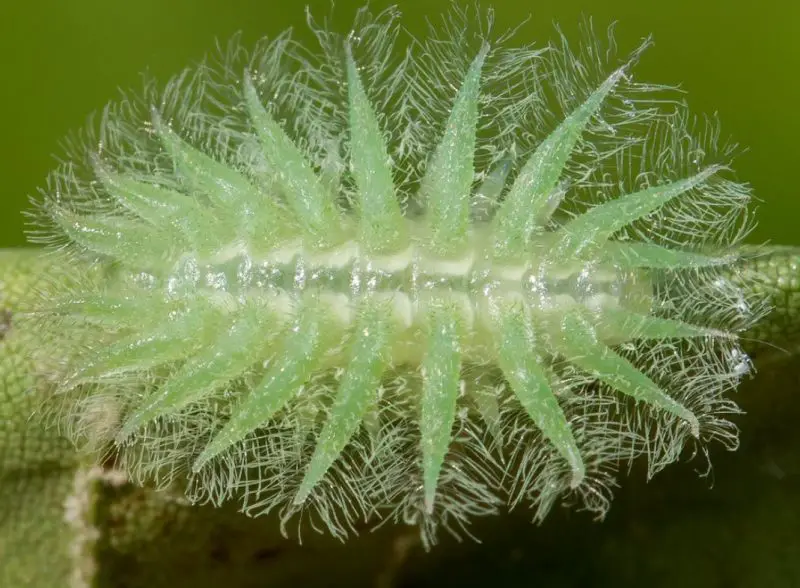
Within the world of caterpillars, the Spun Glass Slug Moth Caterpillar (Isochaetes beutenmuelleri) stands out due to its remarkable combination of green and green-blue colors. Interestingly, this species contains poison glands, which could lead to dermatitis from direct touch.
Primarily occurring in different hardwood forests, they flourish in the shadows of oak and beech trees, concealing themselves with their rich green leaves. These caterpillars are not very dangerous to their host trees, despite their ravenous appetite for the leaves of oak and beech trees.
When they turn into moths, they go through a stunning color change, becoming colors of gray and brown, which signifies the end of their amazing life cycle.
Spiny Oak-Slug Moth Caterpillar
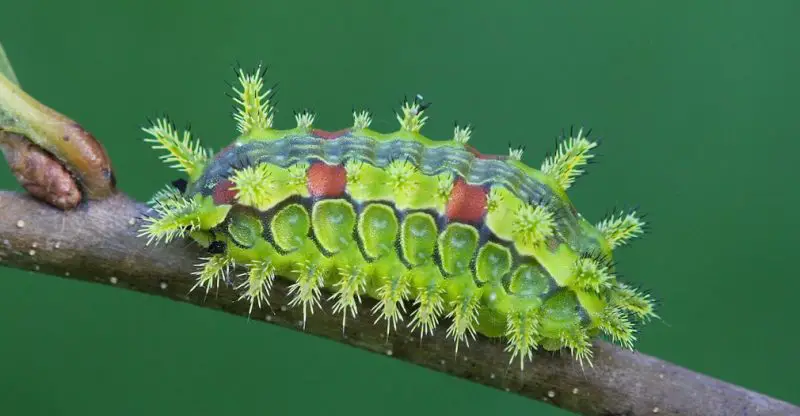
Euclea delphinii, the scientific name for the Spiny Oak-Slug Moth Caterpillar, gets its name from the many spines that cover its body. This widespread species has a vivid, multicolored shell that captivates onlookers with its complex coloration.
Its color changes significantly during the course of its growth stages; at times, the color of its spines seems yellow in comparison to its body. Its final growth phases also begin when characteristic blue marks appear at the base of its spines.
These caterpillars are found all over North America and feed on a wide variety of plants, such as ash, apple, blueberry, and oak trees, demonstrating their adaptation to many environments and food sources.
Abbott’s Sphinx Caterpillar
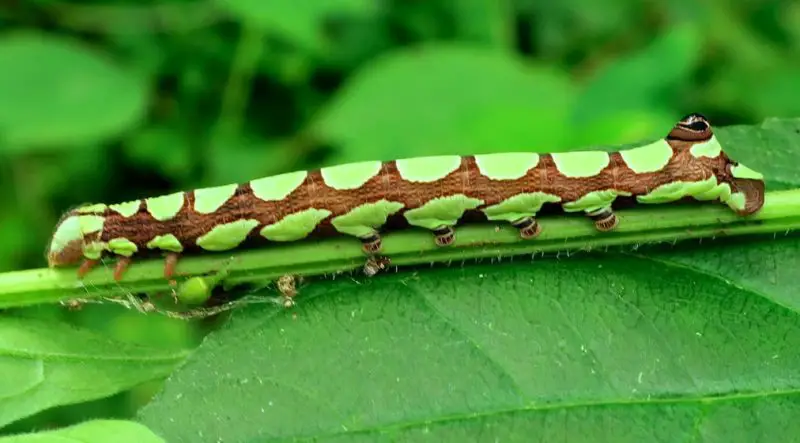
Sphecodina abbottii, the scientific name for Abbott’s Sphinx Caterpillars, are masters of disguise throughout their life cycle.
Their survival strategy is demonstrated by their capacity to blend in with their environment. As they develop, these caterpillars exhibit an amazing change in color from dark green to blue, with subtle brown undertones that mimic the complex coloration of their adult moth counterparts.
It’s interesting to note that grapevines and grapes, these caterpillars’ preferred host plants, may have an impact on their blue tones.
Abbott’s Sphinx Caterpillars are found in several broods throughout the Southern states of the United States. They are resilient and adaptive animals that thrive in a variety of habitats.
Franck’s Sphinx Caterpillar
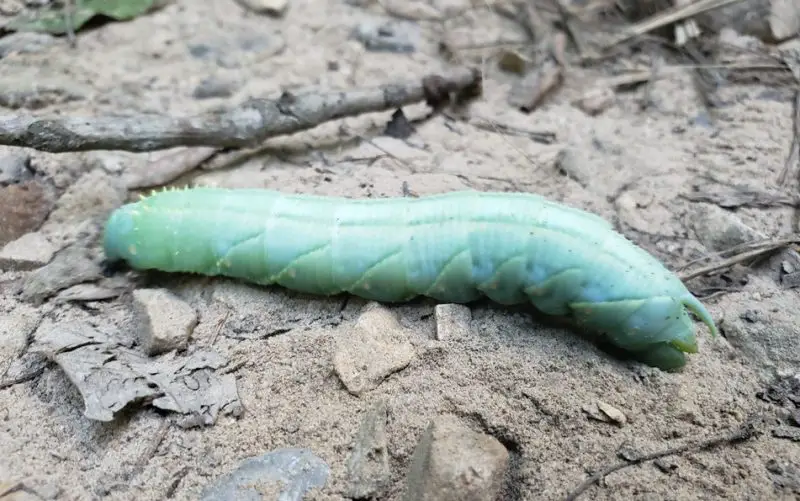
The Franck’s Sphinx Caterpillar, scientifically known as Sphinx franckii, changes color from a light green to an enthralling blue-green as it grows through its several stages of development.
The caterpillar exhibits minor alterations in tandem with this shift, with its darker phases having distinct blue undertones and being covered in small yellow spots all over its body.
Although they are most commonly found on ash and fringe trees, these caterpillars can also be seen as a lovely sight on ornamental plants such as purple lilac.
They are widely distributed throughout the United States and, in the South, they display a pattern akin to their Abbott’s Sphinx Caterpillar counterparts, with numerous broods.
Calleta Silkmoth Caterpillar
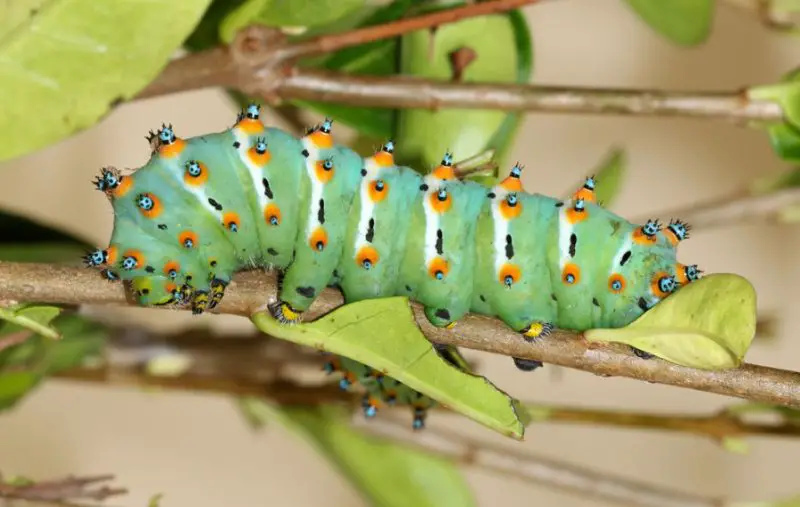
The Eupackardia calleta, or Calleta Silkmoth Caterpillar, is a species of caterpillar that is mostly found in Arizona, New Mexico, and Texas in the United States.
This species mimics toxicity to potential predators by developing tiny red and blue dots with beautiful blue ornamental patches on its body as it ages. Its most frequent predators are still raccoons, despite this visible deterrence.
The principal hosts of this species are Mexican jumping beans and different hardwood trees, which offer them both food and cover during their life cycle.
The Calleta Silkmoth Caterpillar is a distinctive and fascinating resident that sticks out among the colorful landscapes of its environment.
Walnut Sphinx Caterpillar
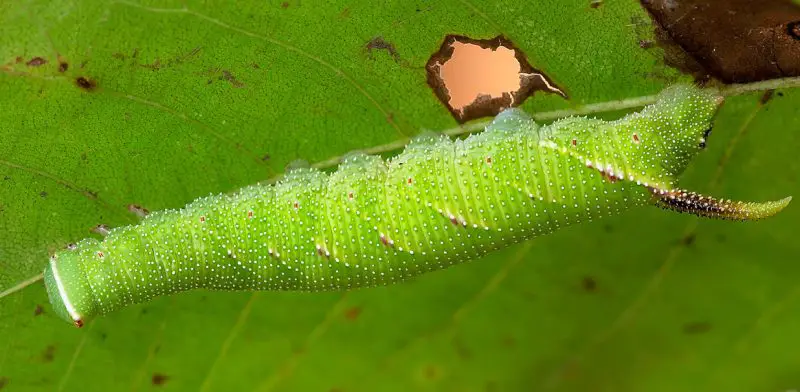
The mature form of the Walnut Sphinx Caterpillar (Amorpha juglandis) is a striking green-blue color; in its early stages, it is a lush green. Light blue colors adorn its dorsal side as it grows, with yellow stripes running along its lateral margins.
Even though the caterpillar might not seem like much, in some areas it can quickly become a problem. It is a hazard to poorly managed plantations of walnut, hazelnut, and alder trees, as it predominantly feeds on their leaves.
The adult moth doesn’t eat at all, in contrast to its ravenous larval stage. These caterpillars, which are common in Eastern North America, usually appear in May and can cause havoc from June to August, particularly in dry spells.
Regal Moth Caterpillar
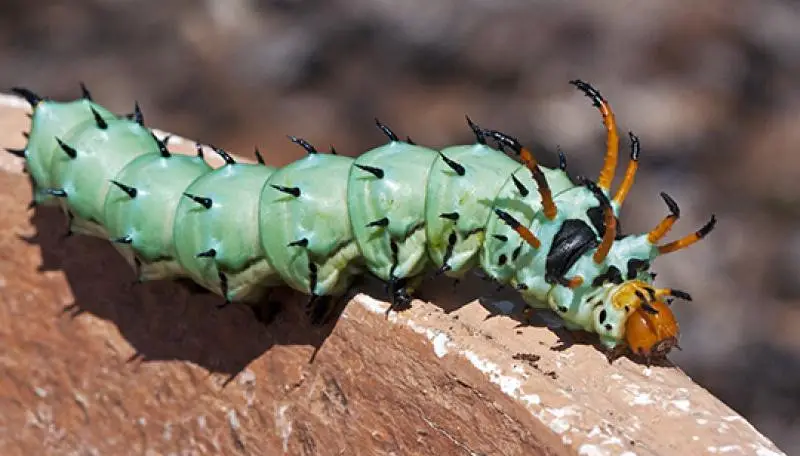
At three times the length of many of its contemporaries, the Regal Moth Caterpillar (Citheronia regalis) is one of the largest caterpillars in the world, reaching lengths of up to 4.9 inches.
Later growth phases see it change from its original brown color to a startling green-blue hue. Despite their enormous size, these caterpillars could be dangerous for hickory, walnut, and hazelnut trees.
However, because they only eat so much before becoming prey for predators, the harm they cause is negligible. Even when this species transitions to the pupa stage, it is still at risk of being eaten by different kinds of tachinid flies, therefore its major enemies are predatory wasps and tachinid flies.
Cecrops Eyed Silkmoth Caterpillar
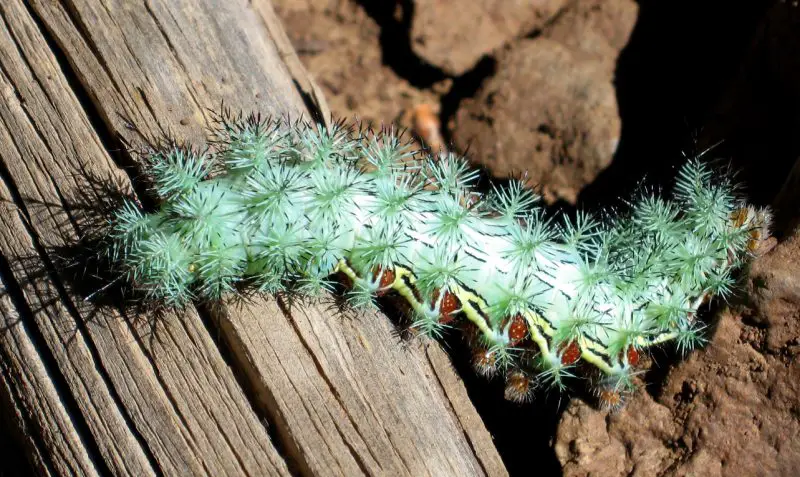
The Cecrops Eyed Silkmoth Caterpillar, which is a member of the Automeris cecrops species, is easily identified by its eye-catching eyespots, which are a protection mechanism against predators and are mirrored in size.
When these caterpillars reach adulthood, their bodies are covered in frightening black spikes that give them an enticing combination of green and blue colors. Their preferred habitats are forests and scrub areas.
They graze on flowers and different types of oak leaves because the adult moths do not eat. One of their favorite hosts is the Fendler ceanothus, or deer brier, a shrub that resembles the Cecrops Eyed Silkmoth Caterpillar itself with its spines.
Cecropia Moth Caterpillar
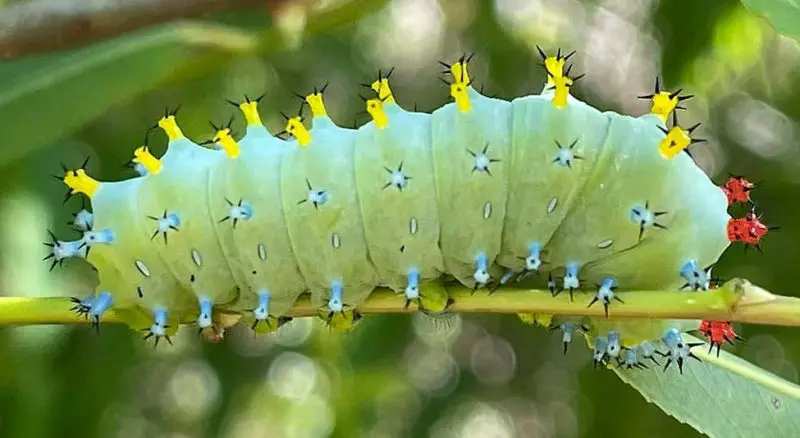
During its growth phases, the Cecropia Moth Caterpillar, formally known as Hyalophora cecropia, experiences an amazing color shift. It is brown or black at first, turning green-blue in the third instar and blue or orange tubercles in the fifth instar, which can occasionally show both colors at the same time. The caterpillar’s dorsal center and sides are adorned with these vibrant tubercles, which further contribute to its unique appearance.
Although its major habitats are beech trees, hemp, and rose bushes, the Cecropia Moth Caterpillar is a benign presence that does not do substantial harm to its host plants.
Their populations are naturally regulated by wasp predation. Interestingly, the Cecropia Moth only lives 10–14 days after attaining adulthood since it can no longer feed itself because its mouthparts are no longer functioning.
Promethea Silkmoth Caterpillar
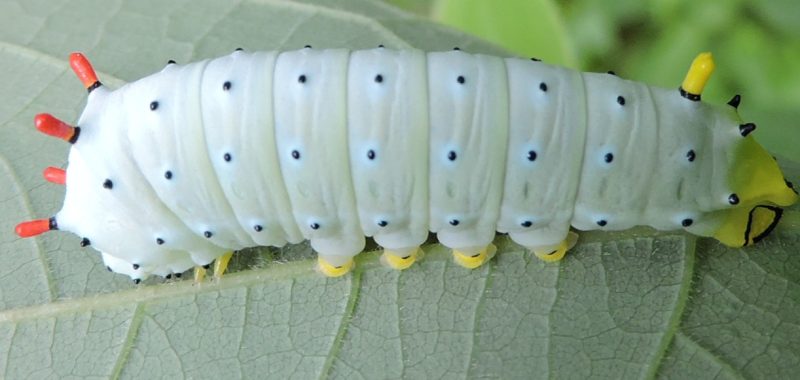
The Promethea Silkmoth Caterpillar, scientifically known as Callosamia promethea, begins its life as yellow eggs with brown markings on them, which are the stage before they hatch. Mostly found on spicebush, they are not considered pests in their natural habitats because they are gentle on their hosts.
These caterpillars’ original color scheme of brown and yellow changes as they become older. Their last instar, which is distinguished by red protuberances or markings, a characteristic of their advanced growth phases, is characterized by a remarkable blue-green color that begins in the third instar and lasts until the end.
As it reaches adulthood, the Promethea silkmoth’s coloration transitions from brown to tan, giving a nostalgic tribute to its caterpillar form’s early phases. This graceful transition from youth to maturity is quite remarkable.
Ilia Underwing Caterpillar
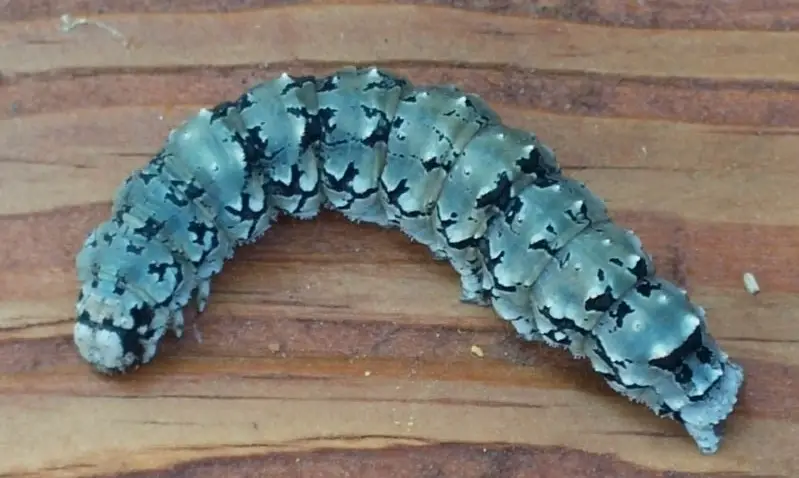
The scientific name for the Ilia Underwing Caterpillar is Catocala ilia, and it shows a remarkable difference from adult moth counterparts. These caterpillars are a visual marvel, adorned in colors of blue-green with brilliant pink to scarlet on their ventral side, complimented by characteristic black markings.
Originally from the East Coast of the United States, their range is beginning to extend westward past the Rocky Mountains. Living in forests, their main food source is oak leaves, with a preference for red and white oaks. They are not a serious threat to these trees, despite their voracious hunger for oak leaves.
They are difficult to spot for the uninitiated because of their coloring, which mimics the bark of trees. They have a significant change in appearance as adults, with prominent orange and black stripes on their hindwings, which contrasts with their juvenile camouflage.
Forest Tent Caterpillar Moth Caterpillar
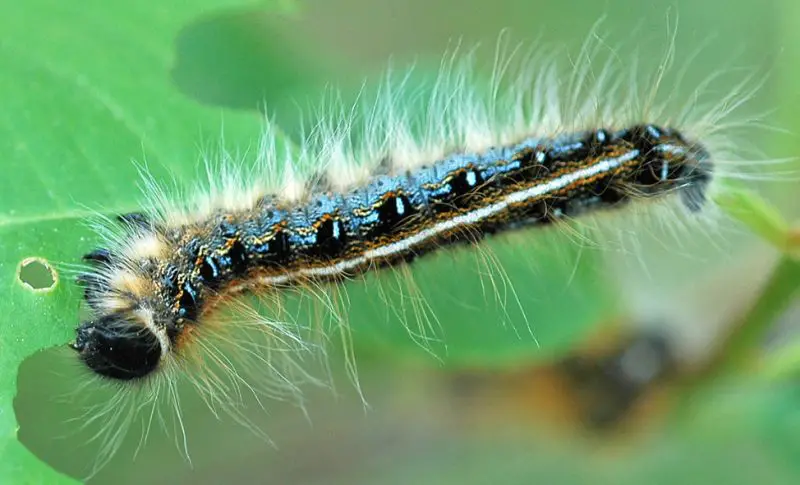
The Forest Tent Caterpillar Moth Caterpillar, formally known as Malacosoma disstria, is characterized by its characteristic transparent blue stripes that are accented by species-specific black, orange, and white markings.
These clever caterpillars use silk to navigate across their arboreal homes, a navigational strategy that is vital to their survival.
Their natural tendency to group together for assistance arises from the difficulty they have in making silk in the early stages of their lifecycle, especially in the first instars. They live as a community because they rely on the common silk roads that have been established by the group.
But this reliance on silk for locomotion can also occasionally cause problems; young caterpillars that are unable to generate or use these silk pathways well may find themselves hanging precariously from the host tree.
People Who Read This Also Read:


